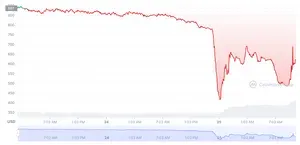ETHTrustFund rug pulls for $2.2 million
- ETHTrustFund, Rekt [archive]
Almost $300,000 stolen from Olympus DAO, later returned
Olympus DAO wrote in an announcement that "This bug was not found by 3 auditors, nor by our internal code review, nor reported via our Immunefi bug bounty." They also noted that because they had done a phased rollout of the contract, only a limited amount of the project's substantial funds were at risk.
Olympus DAO initially announced that they would "compensate all affected bonders in full", but later revealed that the stolen funds had been returned. According to The Block, the Olympus team had successfully tracked the hacker and negotiated the return of the funds.
Investors suffer enormous losses as "cascading liquidations" tank the Wonderland protocol token price below its supposed intrinsic value
The $TIME tokens are issued against a set of assets that supposedly give the token an intrinsic value, and if the price drops below the backing price, the protocol uses the assets in their treasury to buy back the token to bring it back up to its "fair value". In the day following the crash, the protocol's founders spent several million dollars in buy-backs, which briefly boosted the token back up to trading at around $600.
The project's team reportedly suffered major liquidation losses themselves, with the founder Daniele Sestagalli losing $15 million and the chief developer "0xSifu" losing $1.6 million. Sestagalli briefly caused panic in the community when he set his 300,000+ follower Twitter account to private after tweeting "Dude I just woke up losing 10 m dollars", but set the account back to public shortly after. He retweeted a thread stating that "the internal struggle for growth is cut short by the willingness of some entities to 'eat' all that they'r able to, instead of 'cultivating' and sharing what would be exponential profits in the future."




